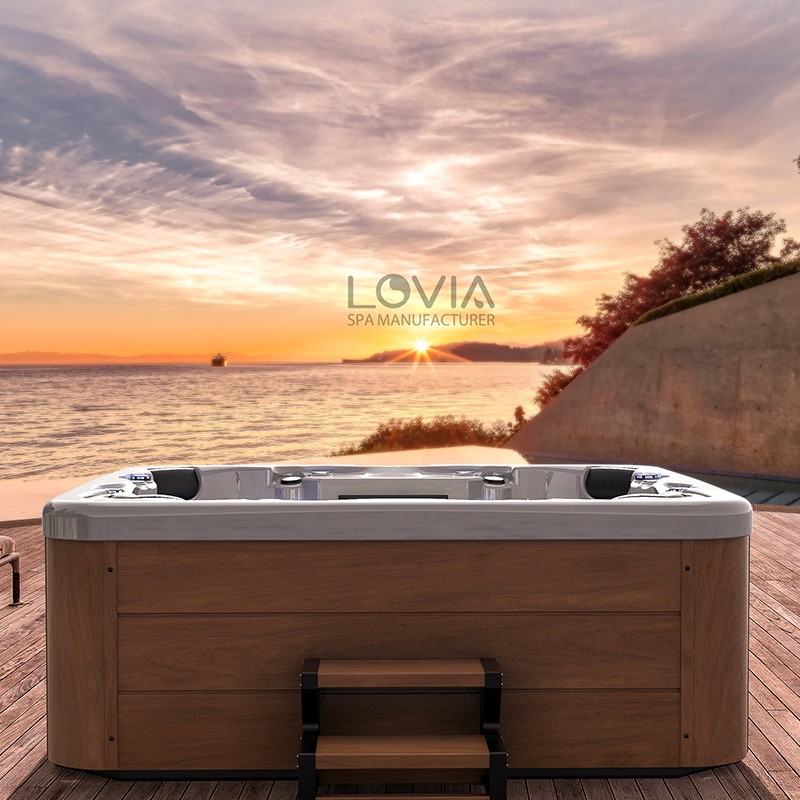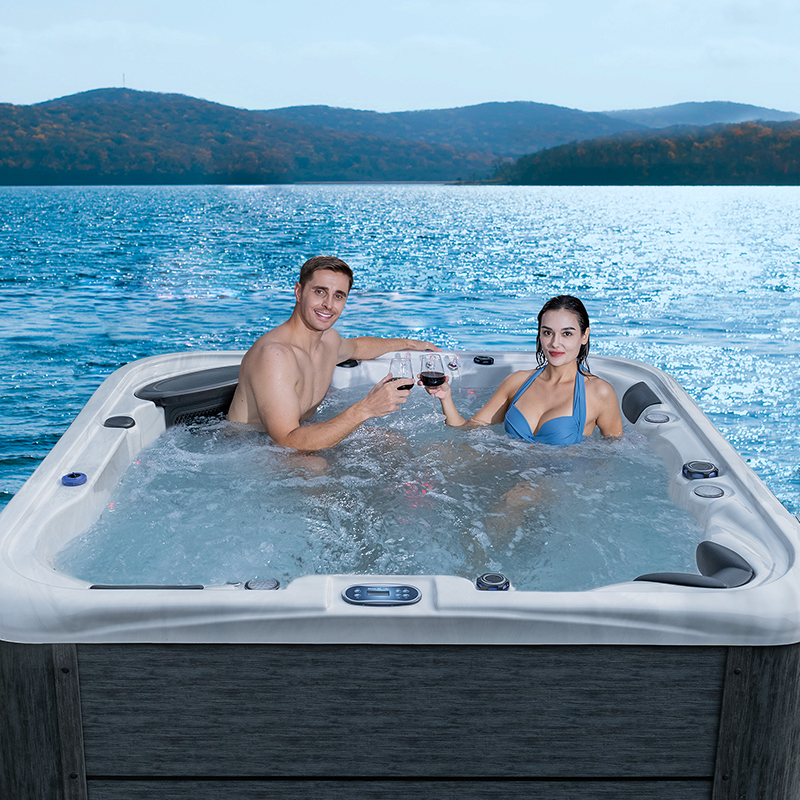
Is Biofilm in Whirlpool Spa Hot Tubs Harmful to Humans?
2025-11-15 15:30Whirlpool spa hot tubs are widely used in modern homes and spas for relaxation, muscle soothing, and stress reduction. However, in these warm, humid environments, a hidden problem often overlooked is quietly lurking – biofilm.
Many people enjoy hot water massages without realizing that, if not properly maintained, a large amount of microorganisms can grow on the inner walls, pipes, and nozzles of the whirlpool spa hot tub, forming a biofilm. This article will explore in depth: Is biofilm in whirlpool spa hot tubs harmful to humans? How does it form? And how can we prevent and remove it?

What exactly is "biofilm" in whirlpool spa hot tubs?
To understand the dangers of biofilm in whirlpool spa hot tubs, we first need to understand what it is.
1. Definition of Biofilm
A biofilm is a protective layer formed by microbial communities such as bacteria, fungi, and algae adhering to a solid surface and secreting a sticky substance. This "film" not only adheres to the inner walls of water pipes, nozzles, and filters, but also resists removal by external disinfectants.
2. The Formation Process of Biofilm
In the whirlpool spa hot tub, the warm water temperature (usually maintained at 37–40°C) provides an ideal environment for microbial reproduction.
The formation process is as follows:
• Stage 1: Microorganisms attach to the surface of the tub's pipes.
• Stage 2: Bacteria begin to secrete polysaccharides, forming an initial film layer.
• Stage 3: Multiple microbial species aggregate to form a stable ecosystem.
• Stage 4: The mature biofilm releases cell debris and new microorganisms, spreading throughout the system.
Due to continuous water circulation, these biofilms form "hidden sources of bacteria" throughout the whirlpool spa hot tub, which are difficult to detect with the naked eye.

Is the structure of the whirlpool spa hot tub prone to biofilm growth?
1. The Complex Structure of Pipes and Nozzles
The biggest difference between the whirlpool spa hot tub and a regular bathtub lies in its complex internal structure. Components such as the circulation pipes, bubble nozzles, and filtration devices provide attachment surfaces for microorganisms. Especially after the bathtub stops running, residual warm water and organic matter (such as skin flakes and shower gel residue) become a breeding ground for bacteria.
2. The Dual Effect of Temperature and Humidity
Most bacteria multiply fastest in warm, humid environments. The whirlpool spa hot tub's thermostatic system maintains the water temperature within a range suitable for microbial growth.
Simultaneously, high humidity keeps the bathtub surface constantly moist, further promoting biofilm formation.
3. Disinfection Dead Zones and Maintenance Cycle Issues
Even with regular water changes or the addition of chlorine disinfectant, dead zones in the whirlpool spa hot tub (such as the inside of the nozzles and the connection to the circulation pump) are often not thoroughly cleaned. These areas are the "hidden spots" where biofilm most easily forms.
Is the biofilm in the whirlpool spa hot tub really harmful to humans?
This is the question most users are most concerned about. The answer is: Yes, biofilm may pose a potential health risk to humans, especially when not properly maintained.
1. Bacterial Species in Biofilms
Studies have shown that common biofilms in whirlpool spa hot tubs contain the following bacteria:
•Pseudomonas aeruginosa: Can cause skin infections, folliculitis, and otitis externa.
•Legionella pneumophila: Can cause Legionnaires' disease (severe pneumonia).
•Staphylococcus aureus: Can cause purulent skin lesions.
•Molds and yeasts: May trigger allergic reactions or respiratory discomfort.
These bacteria, protected by biofilms, can resist conventional disinfectants, making the water quality appear "compliant" on the surface, but potential risks remain.
2. Potential Human Impact
When people bathe in whirlpool spa hot tubs, pores open and the skin barrier weakens, allowing microorganisms to easily enter the body through tiny openings.
Potential health problems include:
• Skin infections and folliculitis: Red rashes or itching may occur after skin comes into contact with bacteria-containing water.
• Respiratory irritation: Inhaling Legionella-containing aquatic bubbles may trigger coughing or lung infections.
• Eye and ear inflammation: Microorganisms in the water can enter the eyes or ear canals, causing discomfort or inflammation.
While these situations don't occur every time, long-term use of an uncleaned whirlpool spa hot tub does pose a risk of chronic exposure.

Why is biofilm so difficult to remove?
1. Protective natural defenses
The surface of a biofilm is composed of a sticky polysaccharide substance that acts like a "protective shield," preventing the penetration of conventional disinfectants such as chlorine and ozone. Even if the water disinfection level meets standards, bacteria can still survive within the biofilm.
2. Complexity of the micro-ecosystem
In a whirlpool spa hot tub, the biofilm is not a single species of bacteria, but a micro-ecosystem. Different microorganisms are interdependent; some decompose organic matter to provide nutrients, while others can tolerate high temperatures or chemicals. This ecological diversity makes complete removal more difficult.
3. The "Re-infection" Mechanism of Pipe Circulation
Even if some biofilm is damaged, tiny remnants in the circulation system can regenerate rapidly. When water flows again, shed cell clumps adhere to new surfaces, forming a new biofilm within days.
Is cleaning and disinfecting the whirlpool spa hot tub sufficient to prevent biofilm?
This is a crucial question. While cleaning helps, routine maintenance is often insufficient to completely prevent biofilm.
1. Chlorine Disinfection Alone is Insufficient
Conventional disinfectants such as chlorine or bromine are effective at killing free bacteria, but have limited effect on bacteria within biofilms. High concentrations can irritate the skin and respiratory system, creating a dilemma.
2. The Importance of Regular Drainage and Deep Cleaning
To effectively prevent biofilm, the whirlpool spa hot tub should be drained regularly, and internal buildup should be removed using a specialized "pipe cleaner." These products typically contain enzymes or surfactants that break down biofilm.
3. Filtration System Maintenance
Filters that are not replaced or cleaned in a timely manner can become a breeding ground for bacteria. It is recommended to thoroughly flush the filter cartridge every 1-2 weeks and replace it periodically according to usage frequency.
Can the risk be reduced by controlling water quality parameters?
1. Maintain a suitable pH level
The pH level in the whirlpool spa hot tub should be maintained between 7.2 and 7.8. Too acidic or too alkaline a pH will affect the effectiveness of disinfectants and may also accelerate pipe wall corrosion, providing a surface for microorganisms to attach to.
2. Control total dissolved solids (TDS)
High TDS means that the water contains more organic matter and mineral residues, which promotes biofilm formation. Regular water changes can effectively control this indicator.
3. Maintain continuous circulation
Avoid prolonged stagnant water. Regularly running the circulation pump can reduce dead water zones and inhibit biofilm formation.
How to protect yourself from biofilm hazards when using a whirlpool spa hot tub?
Even if biofilm cannot be completely eliminated, we can still take measures to reduce the risk.
• Rinse before bathing: Wash away oils and cosmetics from the skin's surface, reducing the amount of organic matter entering the bathtub.
• Rinse after bathing: Rinse your body with clean water afterward to avoid bacterial residue.
• Avoid bathing with open wounds: Broken skin is a pathway for bacteria to enter.
• Regularly test water quality: Use water quality test strips to check chlorine content, pH level, and other indicators.
• Reasonable usage time: Limit each bath to 15-20 minutes to avoid overexposure.

Does biofilm mean you can't use the Whirlpool spa hot tub?
The answer is no. The Whirlpool spa hot tub itself is not unsafe; the key is maintenance and management.
By following these points, you can safely enjoy a spa experience:
• Filter and disinfect before and after each use;
• Clean the pipes regularly with a professional cleaner;
• Maintain good water quality monitoring and frequent water changes.
Proper maintenance not only prevents biofilm growth but also extends the life of the equipment, allowing the spa to truly provide relaxation and health benefits.
Can I Order Customized Branding or OEM Service?
Yes. LOVIA SPA welcomes OEM and ODM projects. Buyers can personalize logos, panels, control systems, and even packaging for private-label sales. Our professional R&D and production teams provide complete OEM service with competitive factory prices and minimum order flexibility.
As a long-established manufacturer, we supply branded spas for international importers seeking reliable long-term cooperation.
